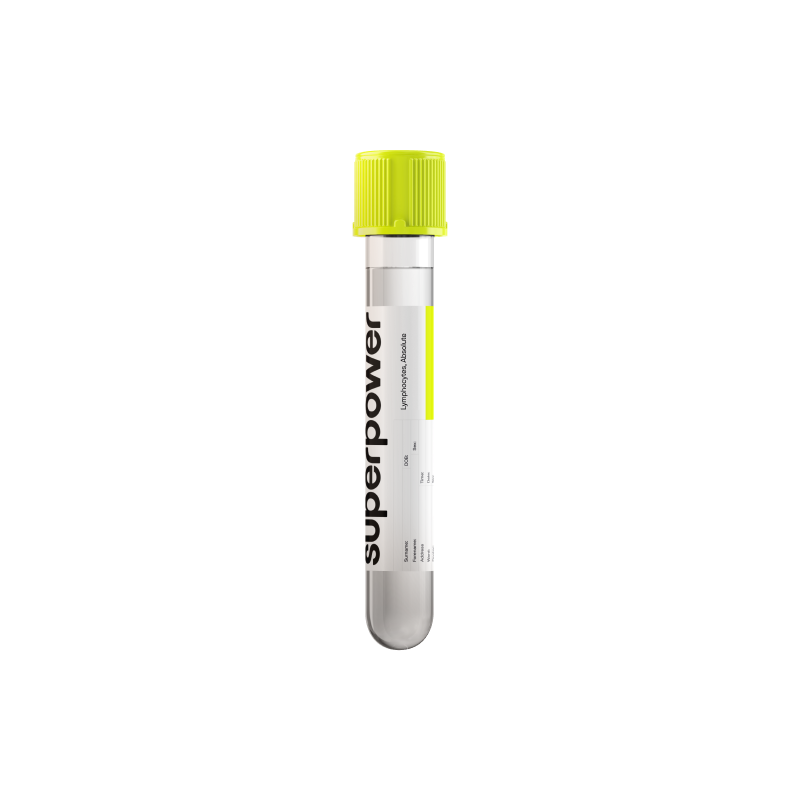Lymphocytes, Absolute testing measures the total number of T cells, B cells, and natural killer (NK) cells circulating in your blood. These cells direct, execute, and regulate adaptive immunity. The result comes from a standard complete blood count (CBC) with differential using automated analyzers. Unlike the percentage, which shows proportion, the absolute number gives the true count per volume, offering a direct read on immune readiness.
Lymphocytes coordinate defense against viruses, support cancer surveillance, and maintain immune memory. Balanced numbers support resilience and controlled inflammation. Stress hormones, exercise, infection, smoking, nutrition, and medications all influence the count.
Key Benefits
- See your immune status by measuring lymphocyte white blood cell count.
- Spot low counts that raise risk for viral and unusual infections.
- Flag high counts that suggest recent viral illness or certain blood disorders.
- Explain recurrent infections, fevers, or swollen nodes by checking lymphocyte levels.
- Guide treatment safety monitoring on steroids, chemotherapy, or biologic therapies.
- Track recovery after illness or therapy using simple count trends.
- Clarify drug, stress, or autoimmune causes of low lymphocytes.
- Best interpreted with total white count, cell breakdown, and your symptoms.
What is Lymphocytes, Absolute?
Lymphocytes, Absolute is the total number of lymphocytes circulating in a set volume of blood. Lymphocytes are a family of white blood cells (leukocytes) that arise in the bone marrow and populate the immune system’s organs. They include T cells (T lymphocytes), which mature in the thymus; B cells (B lymphocytes), which mature in the bone marrow; and natural killer cells (NK cells). These cells continuously circulate between blood, lymph nodes, spleen, and mucosal tissues. “Absolute” means the actual number of these cells, not just their percentage among white blood cells.
This count represents the available pool of immune cells that recognize new invaders and remember past ones. T cells coordinate responses and directly eliminate infected or abnormal cells (cell-mediated immunity). B cells produce antibodies that neutralize pathogens (humoral immunity). NK cells provide rapid, non-specific cytotoxic defense. The absolute lymphocyte count therefore reflects the body’s adaptive immune capacity and innate surveillance at a given moment, shaped by how many lymphocytes are produced in lymphoid organs, released into blood, redistributed into tissues, and how long they survive.
Why is Lymphocytes, Absolute important?
Absolute lymphocytes count measures how many lymphocytes—T cells, B cells, and natural killer cells—are circulating at a given moment. These are the cells that recognize new threats, remember old ones, and coordinate targeted defense. Because they link bone marrow, lymph nodes, spleen, mucosal surfaces, and hormones, this single number reflects immune resilience across body systems.
Most labs consider a usual adult range around 1 to 3, with children typically higher. Values that sit steadily in the middle and stay stable over time are generally associated with balanced, ready-but-not-overactive immunity.
When the count is too low, it signals reduced adaptive immunity (lymphopenia). This can follow acute illness or surgery, high stress hormones or corticosteroids, malnutrition or protein loss, autoimmune disease, HIV, or bone marrow–suppressing therapies. People may notice more frequent or severe viral infections, slow recovery, shingles reactivation, mouth ulcers, or poor vaccine responses. Older adults face higher risks from pneumonia and influenza. Pregnancy often shows a mild, physiologic dip as the immune system shifts toward tolerance; in children, persistently low values with recurrent infections warrant attention.
When the count is high, it usually reflects active immune stimulation. Short-lived rises are common with viral infections, especially in kids. In adults, persistent elevation can point to chronic infection, autoimmune activity, smoking-related stimulation, or clonal lymphocyte expansion such as chronic lymphocytic leukemia, sometimes with swollen nodes, night sweats, or spleen enlargement.
Big picture: absolute lymphocytes integrate marrow output, thymic education, and antigen exposure, and they interact with neutrophils, monocytes, and inflammation markers. Chronically low levels track with infection risk and frailty; chronically high levels raise concern for ongoing immune drive or lymphoid cancers.
What Insights Will I Get?
Absolute lymphocytes quantify the number of lymphocyte white cells in blood—T cells, B cells, and natural killer cells. This index of adaptive immune reserve and activation influences infection control, vaccine response, cancer surveillance, and the inflammatory tone that shapes energy and recovery.
Low values usually reflect reduced production, redistribution, or increased loss of lymphocytes (lymphopenia). Typical drivers are stress hormones or steroids, acute illness, undernutrition, marrow suppression, autoimmune destruction, and infections such as HIV. System effects include higher viral/opportunistic infection risk and weaker vaccine responses. Counts run lower with aging and in pregnancy; children naturally run higher.
Being in range suggests adequate immune capacity with balanced T‑, B‑, and NK‑cell function, enabling efficient pathogen control without chronic overactivation. In adults, optimal generally sits near the mid‑range and is stable when health, sleep, and stress rhythms are steady.
High values usually reflect reactive immune activation (lymphocytosis), often after viral infections, pertussis, chronic inflammation, smoking, or splenectomy. Persistently high counts—especially in older adults—can indicate clonal expansions such as chronic lymphocytic leukemia. System effects mirror the cause: recent infection with lymph node swelling and fatigue, or hematologic disease if clonal.
Context matters: counts vary by time of day (lower with morning cortisol), exercise, acute illness, and vaccination. Corticosteroids and many immunosuppressants lower counts; some therapies or rebound can raise them. Interpret the absolute count with the total white count and differential; percentages can mislead when neutrophils shift. Age‑specific ranges differ.



.svg)



.png)
.png)
.png)
.png)








